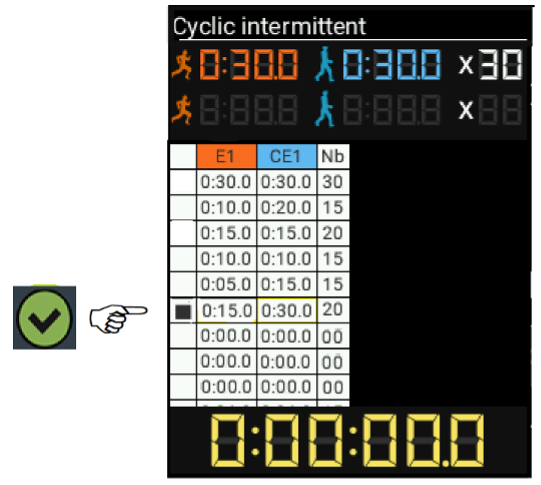Intermittent exercise
In this first step, we will explore the nature of intermittent exercise as well as its importance in sports training. The term “intermittent” refers to something that happens in intervals, with successive periods of shutdown and recovery. Intermittent exercise is therefore characterized by alternating phases of intense effort and recovery phases.
These recovery phases can take two main forms:
- passive
- actiV
Passive recovery involves complete rest or low-intensity activities such as walking or standing still. Active recovery, on the other hand, involves light physical activity, such as running at a moderate intensity.
It’s essential to note that intermittent exercise comes in a variety of forms, each with its own characteristics and benefits. Some of the most common are:
1.Short interval training
Short intermittent sessions are a crucial part of running training, aimed at improving Maximum Aerobic Speed (MAS) and Maximum Oxygen Consumption (VO2 Max). These sessions are usually performed at a high intensity, close to or above 100% of the MAS, and consist of repetitions of short periods of intense exertion followed by short periods of active or passive recovery.
One of the most popular intermittent exercises is the 30-30, which involves intervals of 30 seconds at maximum intensity, followed by 30 seconds of recovery. For well-trained athletes, the intensity can even slightly exceed 100% of the MAS, going up to 105% in some cases. These intense efforts put a lot of strain on the cardio-respiratory and muscular systems, thus stimulating the improvement of aerobic and anaerobic capacities.
The main goal of these sessions is to develop the MAS, which represents the maximum speed at which an athlete can run using their aerobic system. By performing repetitions of intense efforts at speeds close to their MAS, runners improve their ability to maintain a fast pace over shorter distances, which is beneficial for sprints and accelerations during races.
In addition, short intermittent sessions also contribute to the improvement of VO2 Max, which represents an athlete’s maximum ability to use oxygen during exercise. By putting an intense strain on the cardio-respiratory system, these sessions stimulate the adaptation of the muscles and lungs to absorb and transport oxygen, resulting in an improvement in overall running performance.
By incorporating regular short intermittent sessions into their training program, runners can gradually improve their MAS, VO2 Max, and ability to maintain a high pace over shorter distances. These performance gains will result in faster and more efficient races, both in terms of speed and endurance.
2.Short intermittent sessions
Long intermittent sessions are an essential component of sports training, often complementary to short intermittent sessions.Unlike short intermittent sessions that emphasize short-term intense efforts followed by recovery periods, long intermittent sessions are characterized by prolonged periods of exertion at a high level of intensity.
Typically, these sessions take place at a rate of about 95% of the Maximum Aerobic Speed (MAS), which represents a sustained but controlled effort. Running at this percentage of MAS requires strong mental focus and an ability to maintain a high pace over an extended period of time
One of the main objectives of long intermittent sessions is to develop the mental health of the athletes. Running at a high intensity for an extended period of time tests athletes’ mental resilience, pushing them to push their limits and maintain their performance even when fatigue begins to set in.
In addition to strengthening the mind, these sessions are also beneficial for building stamina and endurance. Maintaining an intense effort for a prolonged period of time effectively engages the cardio-respiratory and muscular systems, thus promoting the improvement of aerobic and anaerobic endurance.
By incorporating long intermittent sessions into their training schedule on a regular basis, athletes can gradually improve their ability to maintain a sustained pace over longer distances, which is essential for performing at their best in competitions and matches.
3.Hill interval training
Hill interval training has many advantages:
Firstly, they allow you to work on your MAS as much as on the flat
In addition, this type of session naturally strengthens the thighs and calves. As you will be more muscular, sessions on the flat will seem easier.
It also improves stride efficiency.
4.Pyramid interval training
The principle of this type of training is to progressively increase the duration of effort with each new repetition and then return to the initial running duration. This type of session can work runners on short intermittent work as well as on long work in one training session.


